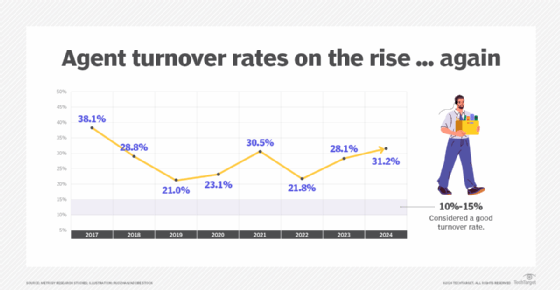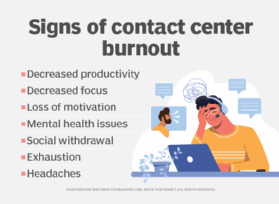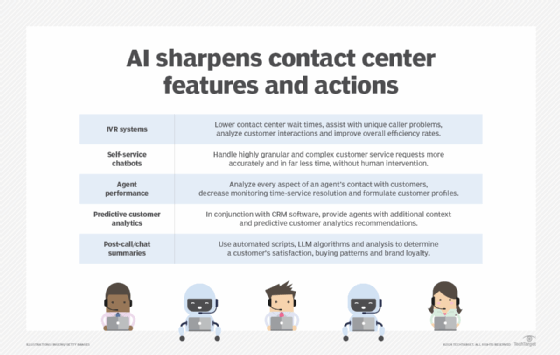Why contact centers have high turnover and how to combat it
The alarming rise in contact center turnover rates negatively impacts agent morale, customer interactions and ROI. In many ways, AI is seen as both the cause and the solution.
Contact center turnover rates are on the upswing again and they don't appear to be settling down anytime soon. Several factors contribute to high turnover rates, including AI, automation, agent burnout and the lack of qualified agents. High agent turnover can lead to bad customer experiences in the contact center, brand reputational damage and lost revenue. But businesses can take several actions to stem the flow of turnovers.
What is turnover rate and how is it calculated?
Turnover rates measure the percentage of the total contact center agents who leave their jobs in a given year. Their departure may be by choice, for cause or due to layoffs. Some organizations define turnover rates differently than employee attrition rates. A turnover rate, which Metrigy measures, is simply the percentage of agents that leave the company, while attrition measures agents who leave the company for any reason and aren't replaced.
The rates themselves have been on a roller coaster ride for a while now, according to Metrigy studies that track agent turnover rates over time. Rates dropped from 38.1% in 2017 to 21% in 2019, only to jump to 30.5% at the height of the pandemic in 2021 and drop again to 21.8% in 2022. Rates climbed to 28.1% in 2023 and are projected to reach 31.2% by the end of 2024.
Good turnover rates are considered to be 10% to 15%, but Metrigy research showed that rates at some companies were as high as 85% -- clearly far too high and nearly impossible to deliver solid customer experiences.

Reasons for high turnover rates in contact centers
Turnover rates are driven by several factors. Among them is AI, which had a noticeable impact on contact center staffing for the first time in 2023, according to Metrigy. Following are five key reasons for rising contact center turnover rates:
- AI's impact on agent productivity. When paired with a copilot assistant, agents are more productive. Couple that with transcription and automation of after-call work, and the productivity rates become even more impressive. More efficient agents handle more interactions, so companies don't need as many agents.
- AI's ability to automate customer interactions. AI automates about 41% of customer interactions, so fewer of these exchanges require agent attention. Also, if the company or the number of interactions isn't growing, then fewer agents are required to handle the contact volume.
- Agents capitalizing on rising pay. Agent salaries are increasing because experienced and qualified agents are harder to find and retain. No one can blame agents for capitalizing on a higher-paying position, but it does contribute to agent turnover.
- Agent burnout. With agents now handling mostly complex issues with little downtime, they are simply burning out. In fact, 52% of CX leaders say agent burnout is an issue and causing agents to leave their companies.
- Confusion generated by AI-guided agent desktops. Some companies report losing long-time agents who are uninterested in all the automation, screen pops and AI-enabled assistance. They don't want to use the new technology and are leaving the companies that force it on them.

Turnover is a mix of agents leaving voluntarily and involuntarily -- due to performance issues or the volume of customer interactions. Overall, 36.8% of companies report that they reduced their headcount through layoffs in 2023, and 55.7% have reduced the hiring of new agents because they added AI to the contact center, according to Metrigy's "AI for Business Success" global survey of 697 IT, CX and business leaders. In addition, 38% of companies are still short-staffed in the contact center, primarily because their companies are growing and they simply need more staff in all areas of the company, including the contact center. AI is helping 84.2% of these companies fill the gap, but they still lack enough workers.
Consequences of high turnover rates
When companies have high turnover rates, the most significant impact is poor customer interactions, which is a main contributor to consumer disappointment in the service they receive. Just 19.6% of consumers said customer service has improved in the past year, according to Metrigy's survey of 504 North American consumers.
Ironically, the more agents that leave a company, the faster the revolving door. Morale drops as departures rise because those agents remaining with the company must pick up the slack. Customer satisfaction drops quickly, resulting in less-than-pleasant conversations with customers who have been waiting on hold far too long or have found it difficult to resolve their problems.
High turnover also impacts supervisor time and company costs to find, replace and adequately train new agents. What's more, in revenue-generating contact centers, fewer agents or lesser-trained agents will impact the anticipated revenue the team expects to generate.

Tips to combat high turnover rates
Contact center leaders must evaluate their own causes of high turnover rates, but all companies can follow five universal best practices to help build loyalty and improve agent retention:
- Focus on agent job satisfaction. Many companies have a formal retention program to improve agent loyalty and satisfaction by promoting flexible work schedules, increased compensation and career paths.
- Deploy technology strategically. AI is helping agents become more efficient. When it's deployed properly, customers get faster resolutions. But many companies deploy the technology without explaining to agents and customers why they should use it, decreasing the technology's ROI. It's important to promote technologies appropriately.
- Provide assistance where needed. By integrating unified communications and contact center platforms, companies can bridge the gap between agents and the rest of the company. When agents need help resolving an issue or closing a sale, they can use the collaboration infrastructure to loop in an expert. Likewise, sales, marketing and product development teams can call upon contact center agent expertise to help with campaigns and strategies. As a result, company success metrics can improve overall and it opens up different career opportunities for agents within the company.
- Develop and improve training. Though training is a vital part of any contact center, many agents still can benefit from continuous improvement. AI-enabled training programs build confidence in agents, help them to better meet KPIs and sales quotas, and improve customer interactions -- all of which can increase loyalty and job satisfaction.
- Use AI to identify burnout. Agent burnout will only get worse over time. But sentiment analysis, coupled with agent performance metrics, can signal supervisors when agents need breaks, additional coaching or scheduling flexibility.
Most important is that CX leaders and agents embrace the strong link between agent and customer satisfaction. One measure of agent satisfaction is the turnover rate. When agent turnover stays below 15%, Metrigy's research shows, customer satisfaction increases by 26%.
Robin Gareiss is CEO and principal analyst at Metrigy, which conducts research and advises enterprises and technology providers.






